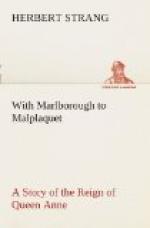9. THE PEOPLE
The population of England in this reign is supposed to have been about five millions. London itself contained half a million, but even the best of the provincial towns were small, as we reckon populations nowadays. Bristol, the second town in size, possessed not more than some thirty thousand souls, while York, Norwich, and Exeter, which came next, had considerably fewer people than that. The bulk of the people lived in the country, either in the villages, or in the petty market-towns which were not much superior. The country squire class was the most important in the community. Below this, but likewise occupying a very important position in the country, were the clergy and yeomen. Probably at no time was the yeoman class more numerous, more prosperous, and more influential. The squire was in point of education often inferior to the well-to-do farmer of our own day, but very proud of his family.
10. THE CLERGY
The clergymen of the period were, as a rule, especially in the remoter districts, men of inferior standing, often of low origin and of little learning. They were badly paid, generally speaking, and often had to eke out a slender income by taking to farming pursuits. It was not at all unusual for the clergyman to marry the lady’s maid or other of the upper servants in the great family of his neighbourhood. Queen Anne, to relieve the poverty of the poorer livings, founded the fund known as Queen Anne’s Bounty, giving up for the purpose the first-fruits and the tenths. It is worth noting that the terms Low and High Churchmen were political rather than religious terms, the former being applied to the Whigs, and the latter to the Tories.
11. DWELLINGS
The style of architecture known as that of Queen Anne prevailed at this time, and many a country mansion of this date, red-bricked and many-windowed, is still to be seen in England. But the houses of the poor were for the most part still wretched, of mud or plaster, and badly thatched. The windows were small and few in number; the furniture was scanty and mean; sanitary matters were scarcely attended to at all. But the growing prosperity of the country was beginning to show itself in the better equipment and furnishing of the household, particularly among the yeomen and the rising town tradesmen. Advantage was taken of the Great Fire to improve the streets and dwellings of the capital.
12. DRESS
Among the gentry the influence of the magnificent court of Louis XIV began to make itself felt in the matter of dress, and both gentlemen and ladies affected gay attire. The hoop-petticoat came into fashion, and the dress was looped up at intervals to show the richly-coloured skirt below. The gentlemen wore knee-breeches and silk stockings, the former ornamented with knots of ribbon; the scarf was very full and rich, and often fell in folds over the front of the waistcoat; the coat was usually gaily coloured. Swords were worn by the gallants, and the periwig was seen everywhere in high society. The dress of the lower ranks was of sober colour, and of stout but coarse texture. The women wore homespun, and sometimes home-woven linsey-woolsies. The use of linen and silk was coming in among those in better circumstances.




